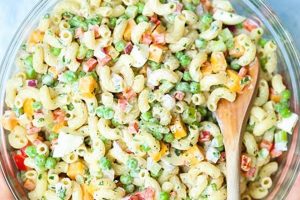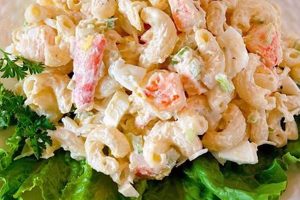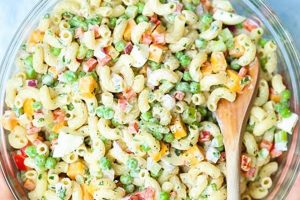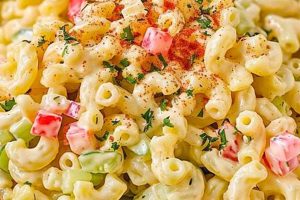A creamy, chilled pasta salad traditionally relies on mayonnaise as its binding agent and primary source of flavor. However, a growing demand for lighter, healthier options, as well as accommodation for dietary restrictions, has led to variations that omit this ingredient. These recipes typically substitute the mayonnaise with alternatives like Greek yogurt, olive oil, avocado, or vinaigrette dressings to achieve a similar texture and flavor profile.
Mayonnaise-free versions offer several advantages. They are often lower in fat and calories, making them a healthier choice. These recipes also cater to individuals with egg allergies or those following vegan or specific dietary regimes. Furthermore, eliminating mayonnaise can broaden the flavor possibilities, allowing for tangier, brighter, and more herbaceous profiles. This versatility opens doors for diverse culinary exploration, using different oils, vinegars, herbs, and spices.
The following sections will explore various approaches to crafting delicious and satisfying pasta salads without mayonnaise. These will include specific ingredient recommendations, preparation techniques, and suggestions for flavor combinations to inspire culinary creativity and cater to a range of preferences and dietary needs.
Tips for Crafting Mayonnaise-Free Macaroni Salad
Achieving a flavorful and satisfying macaroni salad without mayonnaise requires careful consideration of ingredient selection and preparation techniques. The following tips offer guidance for creating a successful dish.
Tip 1: Choose the Right Pasta: Opt for small, sturdy pasta shapes that hold their shape well and absorb dressings effectively. Elbow macaroni, rotini, and shells are excellent choices.
Tip 2: Cook Pasta Al Dente: Slightly undercooking the pasta ensures a firm texture that prevents the salad from becoming mushy. Rinse the cooked pasta under cold water to stop the cooking process and maintain its structure.
Tip 3: Explore Flavorful Alternatives: Greek yogurt, avocado, hummus, or tahini can provide creaminess and richness in place of mayonnaise. Vinaigrettes made with olive oil, vinegar, and herbs offer a lighter, tangier option.
Tip 4: Enhance with Fresh Herbs and Spices: Incorporate fresh herbs like dill, parsley, chives, or basil for brightness and depth of flavor. Spices such as paprika, garlic powder, or onion powder can add complexity.
Tip 5: Add Crunch and Texture: Chopped celery, bell peppers, red onion, or chopped pickles contribute satisfying texture. Roasted vegetables, such as bell peppers or zucchini, offer a deeper flavor profile. Nuts and seeds can also add a welcome crunch.
Tip 6: Balance Flavors: Achieve a harmonious blend of flavors by balancing acidity, sweetness, and saltiness. A touch of lemon juice or vinegar can brighten the salad, while a pinch of sugar or honey can temper any excessive tartness.
Tip 7: Chill Thoroughly: Allowing the salad to chill for at least an hour before serving allows the flavors to meld and the pasta to absorb the dressing fully. This enhances the overall taste and texture.
By following these tips, one can create a delicious and satisfying macaroni salad without relying on mayonnaise. This allows for healthier choices, caters to various dietary needs, and expands culinary horizons.
These techniques lay the foundation for a wide array of flavorful mayonnaise-free macaroni salads suitable for any occasion.
1. Healthy Alternative Dressings
Healthy alternative dressings play a pivotal role in “macaroni salad recipe no mayo,” offering both flavor and health benefits. Traditional mayonnaise-based dressings contribute significant saturated fat and calories. Substituting these with healthier options allows for a lighter, more nutritious dish without sacrificing flavor. These alternatives often offer unique flavor profiles that complement the other ingredients in the salad.
For example, a Greek yogurt-based dressing provides a tangy, creamy texture similar to mayonnaise but with significantly less fat and more protein. A vinaigrette, composed of olive oil and vinegar, adds a bright, acidic counterpoint to the richness of the pasta and other ingredients. Other options include dressings made with avocado, hummus, or tahini, each offering a distinctive flavor and nutritional profile. The choice of dressing influences the overall taste and nutritional value of the macaroni salad. A lemon-herb vinaigrette creates a lighter, brighter flavor profile, while a creamy avocado dressing delivers a richer, more decadent experience.
Understanding the role of healthy alternative dressings is crucial for creating a successful and satisfying “macaroni salad recipe no mayo.” These dressings not only reduce the overall fat and calorie content but also contribute diverse flavors and textures, expanding the culinary possibilities. This awareness facilitates informed decisions about ingredient selection and allows for customization based on individual dietary needs and preferences. The potential for creative flavor combinations using healthy alternatives ensures a delicious and nutritious final product.
2. Flavorful additions
Flavorful additions are essential in a no-mayo macaroni salad. Because mayonnaise provides a significant flavor base in traditional versions, its absence necessitates thoughtful incorporation of other ingredients to achieve a well-rounded and satisfying taste profile. These additions contribute not only to the overall flavor but also to the texture, color, and nutritional value of the dish.
- Fresh Herbs:
Fresh herbs provide brightness and depth. Options like dill, parsley, chives, mint, and basil introduce aromatic complexity and complement other ingredients. Dill, for example, pairs well with a lemon-vinaigrette dressing, while basil enhances the flavors of roasted vegetables.
- Spices:
Spices add warmth and complexity. Paprika, garlic powder, onion powder, cumin, and chili flakes offer diverse flavor dimensions. Smoked paprika contributes a smoky depth, while a pinch of cayenne pepper adds a touch of heat.
- Vegetables:
Vegetables contribute texture, color, and nutrients. Chopped celery, bell peppers, red onion, cucumbers, and shredded carrots provide satisfying crunch and visual appeal. Roasted vegetables, such as bell peppers or zucchini, offer a deeper, caramelized flavor profile.
- Other additions:
Ingredients like olives, capers, pickles, or chopped nuts and seeds introduce salty, briny, or crunchy elements that further enhance the sensory experience. For example, Kalamata olives and feta cheese create a Mediterranean-inspired profile, while toasted sunflower seeds provide a nutty crunch.
The strategic combination of these flavorful additions compensates for the absence of mayonnaise, resulting in a macaroni salad that is not only flavorful and texturally interesting but also nutritionally balanced. The interplay of herbs, spices, vegetables, and other additions creates a symphony of flavors that elevates the dish beyond a simple side and into a culinary centerpiece.
3. Textural Variety
Textural variety is a crucial element in a successful no-mayo macaroni salad. Without the creamy, cohesive texture provided by mayonnaise, achieving a pleasant mouthfeel requires careful consideration of the interplay between different textures. A balance of textures elevates the sensory experience, preventing the salad from feeling monotonous or one-dimensional.
- Pasta Shape:
The choice of pasta shape contributes significantly to the overall texture. Small, sturdy shapes like elbow macaroni, rotini, or shells hold their shape well and provide a pleasant chewiness. Larger shapes, like penne or farfalle, offer a different mouthfeel and can create visual interest.
- Crunchy Elements:
Incorporating crunchy elements provides a satisfying contrast to the softness of the pasta. Chopped celery, bell peppers, red onion, cucumbers, or water chestnuts contribute a refreshing crispness. Toasted nuts, seeds, or croutons add a different type of crunch and enhance the overall flavor profile.
- Soft Ingredients:
Softer ingredients, such as cooked beans, chickpeas, or roasted vegetables, create textural contrast and contribute to a more substantial salad. Roasted vegetables, in particular, offer a tender texture and deeper flavor that complements the other ingredients.
- Creamy Alternatives:
While the goal is to avoid mayonnaise, incorporating a healthy creamy element can enhance the mouthfeel. Avocado, Greek yogurt, or hummus can provide a degree of creaminess without the heaviness of mayonnaise. These alternatives also contribute flavor and nutritional value.
The interplay of these textural elements creates a dynamic and enjoyable eating experience. A well-executed no-mayo macaroni salad should offer a balance of chewiness, crispness, and creaminess, ensuring each bite is both satisfying and interesting. This careful consideration of texture elevates the dish from a simple side to a more complex and appealing culinary creation.
4. Proper pasta choice
Pasta selection significantly impacts the success of a mayonnaise-free macaroni salad. Because mayonnaise typically binds ingredients and provides a creamy coating, its absence necessitates choosing pasta shapes that retain their structure and effectively absorb the alternative dressing. This ensures the salad remains appealing and flavorful, preventing a watery or mushy consistency. Opting for small, sturdy shapes like elbow macaroni, rotini, ditalini, or shells allows the dressing to cling effectively, distributing flavor throughout the salad. These shapes also maintain their integrity after cooking and chilling, contributing to a pleasant texture. Conversely, long, thin pasta like spaghetti or linguine becomes cumbersome and difficult to manage in a salad format, and delicate shapes like orzo may become overly soft and lose their individual character.
The practical significance of selecting the correct pasta becomes evident upon tasting. A well-chosen pasta shape will absorb the flavors of the dressing and other ingredients, creating a harmonious and cohesive dish. For instance, a rotini pasta salad with a Greek yogurt dressing will hold the dressing well within its spirals, ensuring every bite is flavorful and creamy. In contrast, a salad made with overcooked spaghetti and the same dressing might result in a diluted flavor and an unappetizing, slippery texture. Furthermore, the visual appeal of the salad is enhanced by choosing pasta shapes that remain distinct and visually appealing after being mixed with the other ingredients.
In conclusion, appropriate pasta selection is fundamental to creating a satisfying mayonnaise-free macaroni salad. Choosing shapes that hold their form, absorb dressing effectively, and contribute to a pleasant texture ensures a successful final product. This attention to detail elevates the dish beyond a simple side, showcasing the thoughtful consideration given to every component. The resulting salad offers not only a lighter and healthier alternative but also a culinary experience that stands on its own merits.
5. Effective Chilling
Effective chilling is crucial for a successful mayonnaise-free macaroni salad. Unlike traditional versions where mayonnaise acts as a stabilizer, the absence of this emulsified ingredient necessitates careful temperature management to ensure food safety and optimal flavor development. Chilling allows the flavors of the various componentspasta, vegetables, herbs, and dressingto meld, resulting in a more cohesive and balanced taste profile.
- Food Safety:
Chilling inhibits bacterial growth, a critical consideration in salads without the preservative qualities of mayonnaise. Prompt and thorough chilling, particularly after the pasta is cooked and the salad assembled, minimizes the risk of foodborne illnesses. Maintaining a refrigerator temperature of 40F (4C) or below is essential for ensuring food safety.
- Flavor Development:
Chilling allows the flavors of the various ingredients to meld and mature. The pasta absorbs the dressing, the herbs release their aromatic compounds, and the vegetables develop a deeper flavor profile. This integration of flavors creates a more complex and satisfying sensory experience. A chilled salad offers a more pronounced and balanced taste compared to a freshly made one.
- Texture Enhancement:
Chilling firms the pasta and vegetables, contributing to a more desirable texture. A chilled salad presents a cleaner, more appealing bite compared to a room-temperature version, which might feel softer or less defined. This enhanced texture is particularly important in no-mayo versions, where the absence of mayonnaise’s binding properties can make the salad more susceptible to becoming mushy.
- Optimal Serving Temperature:
Serving macaroni salad chilled enhances its refreshing qualities, making it particularly appealing in warmer weather. The cool temperature provides a welcome contrast to other dishes and contributes to a more enjoyable dining experience. This refreshing element is especially pronounced in no-mayo versions, which tend to have lighter, brighter flavor profiles.
Therefore, effective chilling is not merely a matter of preference but a critical step in creating a safe, flavorful, and texturally pleasing mayonnaise-free macaroni salad. Proper chilling techniques ensure the salad reaches its full flavor potential while adhering to food safety guidelines, contributing to a satisfying and enjoyable culinary experience.
Frequently Asked Questions
This section addresses common inquiries regarding macaroni salad prepared without mayonnaise.
Question 1: How can a desirable creamy texture be achieved without mayonnaise?
Creaminess can be achieved through various mayonnaise alternatives. Greek yogurt offers a tangy, protein-rich option, while avocado provides a richer, subtly flavored creaminess. Hummus or tahini can also contribute a creamy texture with unique flavor profiles. Alternatively, a small amount of pureed white beans adds creaminess without significantly altering the flavor.
Question 2: What can be used as a binding agent in the absence of mayonnaise?
While some alternatives, like Greek yogurt, possess inherent binding properties, olive oil-based vinaigrettes require a touch of Dijon mustard or a small amount of mashed avocado for emulsification and improved adherence to the pasta.
Question 3: How can the shelf life of mayonnaise-free macaroni salad be maximized?
Proper storage is crucial. An airtight container in a refrigerator maintained at 40F (4C) or below is essential. Consume within three to five days. Avoid leaving the salad at room temperature for extended periods, particularly in warmer environments.
Question 4: Are there suitable vegan alternatives to mayonnaise in macaroni salad?
Numerous vegan options exist. A cashew-based cream, silken tofu blended with nutritional yeast, or a commercial vegan mayonnaise offer comparable creaminess and flavor. Avocado also provides a naturally vegan and healthy alternative.
Question 5: How can the flavor profile be adjusted if the salad seems bland?
Additional acidity from lemon juice or vinegar can brighten the flavors. Incorporating more fresh herbs, spices, or a dash of hot sauce can add complexity. A pinch of salt or a touch of sweetener may also enhance the overall taste.
Question 6: Can frozen vegetables be used in mayonnaise-free macaroni salad?
Fresh vegetables are generally preferred for optimal texture and flavor. If using frozen vegetables, ensure they are thoroughly thawed and drained before adding them to the salad to prevent excess moisture from diluting the dressing and impacting the overall texture.
Understanding these aspects facilitates informed decisions regarding ingredient selection, preparation techniques, and storage practices, ensuring a successful and enjoyable culinary experience.
This information provides a foundation for creating a delicious and satisfying macaroni salad without relying on mayonnaise. Experimentation with different ingredients and flavor combinations is encouraged to discover preferred variations.
Macaroni Salad Recipe No Mayo
Exploration of mayonnaise-free macaroni salad recipes reveals a versatile culinary landscape. Emphasis on healthy alternatives, flavor enhancement techniques, and textural variety demonstrates the potential for creating flavorful and satisfying dishes without reliance on traditional ingredients. Careful consideration of pasta selection, dressing alternatives, and chilling processes contributes significantly to the overall success of these recipes, catering to diverse dietary needs and preferences.
The increasing demand for healthier, more inclusive culinary options positions mayonnaise-free macaroni salad as a relevant and evolving dish. Continued experimentation with ingredients and flavor combinations promises further innovation within this culinary space, offering a refreshing perspective on a classic dish.






